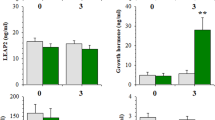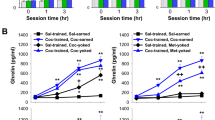Abstract
Rationale and objectives
Ghrelin, an orexigenic (appetite stimulating) peptide activates binding sites in the ventral tegmental area (a structure linked with the neural reward system) allowing it to participate in reward-seeking behavior. An increasing number of studies over the past few years have demonstrated ghrelin’s role in alcohol, cocaine, and nicotine abuse. However, the role of ghrelin, in opioid effects, has rarely been examined. The aim of the present study was to ascertain whether a ghrelin antagonist (JMV2959) was able to inhibit markers of morphine-induced activation of the neural reward system, namely morphine-induced increase of dopamine in the nucleus accumbens and behavioral changes in rats.
Methods
We used in vivo microdialysis to determine changes of dopamine and its metabolites in the nucleus accumbens shell in rats following morphine (MO, 5, 10 mg/kg s.c.) administration with and without ghrelin antagonist pretreatment (JMV2959, 3, 6 mg/kg i.p., 20 min before MO). Induced behavioral changes were simultaneously monitored.
Results
JMV2959 significantly and dose dependently reduced MO-induced dopamine release in the nucleus accumbens shell and affected concentration of by-products associated with dopamine metabolism: 3-methoxytyramine (3-MT), 3,4-dihydroxyphenylacetic acid (DOPAC), and homovanillic acid (HVA). JMV2959 pretreatment also significantly reduced MO-induced behavioral stimulation, especially stereotyped behavior.
Conclusions
Ghrelin secretagogue receptors (GHS-R1A) appear to be involved in the opioid-induced changes in the mesolimbic dopaminergic system associated with the reward processing.




Similar content being viewed by others
References
Abizaid A, Liu ZW, Andrews ZB, Shanabrough M, Borok E, Elsworth JD, Roth RH, Sleeman MW, Picciotto MR, Tschöp MH, Gao XB, Horvath TL (2006) Ghrelin modulates the activity and synaptic input organization of midbrain dopamine neurons while promoting appetite. J Clin Invest 116:3229–3239
Abizaid A, Mineur YS, Roth RH, Elsworth JD, Sleeman MW, Picciotto MR, Horvath TL (2011) Reduced locomotor responsivenes to cocaine in ghrelin-deficient mice. Neuroscience 192:500–506
Acquas E, Di Chiara G (1992) Depression of mesolimbic dopamine transmission and sensitization to morphine during opiate abstinence. J Neurochem 58:1620–1625
Addolorato G, Hillemacher T, Kraus T, Jerlhag E, Bleich S (2009) Hormones and drinking behaviour: new findings on ghrelin, insulin, leptin and volume-regulating hormones. Drug Alcohol Rev 28(2):160–165
Clifford PS, Rodriguez J, Schul D, Hughes S, Kniffin T, Hart N, Eitan S, Brunel L, Fehrentz JA, Martinez J, Wellman PJ (2012) Attenuation of cocaine-induced locomotor sensitization in rats sustaining genetic or pharmacologic antagonism of ghrelin receptors. Addict Biol 17(6):956–963
Davis KW, Wellman PJ, Clifford PS (2007) Augmented cocaine conditioned place preference in rats pretreated with systemic ghrelin. Regul Pept 140:148–152
D’Cunha TM, Sedki F, Macri J, Casola C, Shalev U (2013) The effects of chronic food restriction on cue-induced heroin seeking in abstinent male rats. Psychopharmacology (Berl) 225(1):241–250
De Vries TJ, Shippenberg TS (2002) Neural systems underlying opiate addiction. J Neurosci 22(9):3321–3325
Egecioglu E, Jerlhag E, Salomé N, Skibicka KP, Haage D, Bohlooly-Y M, Andersson D, Bjursell M, Perrissoud D, Engel JA, Dickson SL (2010) Ghrelin increases intake of rewarding food in rodents. Addict Biol 15(3):304–311
Fiserova M, Consolo S, Krsiak M (1999) Chronic morphine induces long-lasting changes in acetylcholine release in rat nucleus accumbens core and shell: an in vivo microdialysis study. Psychopharmacology (Berl) 142:85–94
Howard AD, Feighner SD, Cully DF, Arena JP, Liberator PA, Rosenblum CI, Hamelin M, Hreniuk DL, Palyha OC, Anderson J, Paress PS, Diaz C, Chou M, Liu KK, McKee KK, Pong SS, Chaung LY, Elbrecht A, Dashkevicz M, Heavens R, Rigby M, Sirinathsinghji DJ, Dean DC, Melillo DG, Patchett AA, Nargund R, Griffin PR, DeMartino JA, Gupta SK, Schaeffer JM, Smith RG, Van der Ploeg LH (1996) A receptor in pituitary and hypothalamus that functions in growth hormone release. Science 273:974–977
Hyman SE, Malenka RC, Nestler EJ (2006) Neural mechanisms of addiction: the role of Edward-related learning and memory. Annu Rev Neurosci 29:565–598
Jelhag E, Engel JA (2011) Ghrelin receptor antagonism attenuates nicotine-induced locomotor stimulation, accumbal release and conditioned place preference in mice. Drug Alcohol Depend 117:126–131
Jerlhag E, Egecioglu E, Dickson SL, Andersson M, Svensson L, Engel JA (2006) Ghrelin stimulates locomotor activity and accumbal dopamine overflow via central cholinergic mechanisms: implications for its involvement in brain reward. Addict Biol 11:45–54
Jerlhag E, Egecioglu E, Landgren S, Salome N, Heilig M, Moechars D, Datta R, Perrissoud D, Dickson SL, Engel JA (2009) Requirement of central ghrelin signaling for alcohol reward. Proc Natl Acad Sci U S A 106(27):11318–11323
Jerlhag E, Egecioglu E, Dickson SL, Engel JA (2010a) Glutamatergic regulation of ghrelin-induced activation of the mesolimbic dopamine system. Addict Biol 16:82–91
Jerlhag E, Egecioglu E, Dickson SL, Engel JA (2010b) Ghrelin receptor antagonism attenuates cocaine- and amphetamine-induced locomotor stimulation, accumbal dopamine release, and conditioned place preference. Psychopharmacology (Berl) 211:415–422
Kojima M, Hosoda H, Date Y, Nakazato M, Matsuo H, Kangawa K (1999) Ghrelin is a growth-hormone-releasing acylated peptide from stomach. Nature 402:656–660
Koob GF (1992) Neural mechanisms of drug reinforcement. Ann N Y Acad Sci 654:171–191
Koob GF, Volkow ND (2010) Neurocircuitry of addiction. Neuropsychopharmacol Rev 35:217–238
Leone P, Pocock D, Wise RA (1991) Morphine-dopamine ineteraction – ventral tegmental morphine increases nucleus accumbens dopamine release. Pharmacol Biochem Behav 39(2):469–472
Liu DZS, Liu S, de Vaca SC, Carr KD (2013) Effects of time of feeding on psychostimulant reward, conditioned place preference, metabolic hormone levels, and nucleus accumbens biochemical measures in food-restricted rats. Psychopharmacology (Berl) 227(2):307–320
Maric T, Sedki F, Ronfard B, Chafetz D, Shalev U (2012) A limited role for ghrelin in heroin self-administration and food deprivation-induced reinstatement of heroin seeking in rats. Addict Biol 17(3):613–622
Moulin A, Demange L, Berge G, Gagne D, Ryan J et al (2007) Toward potent ghrelin receptor ligands based on trisubstituted 1, 2, 4-triazole structure. 2. Synthesis and pharmacological in vitro and in vivo evaluations. J Med Chem 50:5790–5806
Naleid AM, Grace MK, Cummings DE, Levine AS (2005) Ghrelin induces feeding in the mesolimbic pathway between ventral tegmental area and the nucleus accumbens. Peptides 26:2274–2279
Paxinos G, Watson C (1986) The rat brain in stereotaxic coordinates. Academic, London
Pothos E, Rada P, Mark GP, Hoebel BG (1991) Dopamine microdialysis in the nucleus accumbens during acute and chronic morphine, naloxone-precipitated withdrawal and clonidine treatment. Brain Res 566(1–2):348–350
Quarta D, Di Francesco C, Melotto S, Mangiarini L, Heidbreder C, Gael Hedou G (2009) Systemic administration of ghrelin increases extracellular dopamine in the shell but not the core subdivision of the nucleus accumbens. Neurochem Int 54:89–94
Rada P, Mark GP, Taylor KM, Hoebel BG (1996) Morphine and naloxone, i.p. or locally, affect extracellular acetylcholine in the accumbens and prefrontal cortex. Pharmacol Biochem Behav 53:809–816
Skibicka KP, Hansson C, Alvarez-Crespo M, Friberg PA, Dickson SL (2011) Ghrelin directly targets the ventral tegmental area to increase food motivation. Neuroscience 180:129–137
Syslová K, Rambousek L, Kuzma M, Najmanová V, Bubeníková-Valešová V, Šlamberová R, Kačer P (2011) Monitoring of dopamine and its metabolites in brain microdialysates: method combining freeze-drying with HPLC-ESI-MS/MS. J Chromatogr A 1218(21):3382–3391
Tessari M, Catalano A, Pellitteri M, Di Francesco C, Marini F, Gerrard PA, Heidbreder CA, Melotto S (2007) Correlation between serum ghrelin levels and cocaine-seeking behaviour triggered by cocaine associated conditioned stimulus in rats. Addict Biol 12:22–29
Wellman PJ, Clifford PS, Rodriguez J, Hughes S, Eitan S, Brunel L, Fehrentz JA, Martinez J (2011) Pharmacologic antagonism of ghrelin receptors attenuates development of nicotine induced locomotor sensitization in rats. Regul Pept 172(1–3):77–80
Wise RA, Bozarth MA (1987) A psychomotor stimulant theory of addiction. Psychol Rev 94(4):469–492
Wurst FM, Rasmussen DD, Hillemacher T, Kraus T, Rasmkogler K, Lesh O, Bayerlein K, Schanze A, Wilhelm J, Wiesbeck G, Kornhuber J, Blech S (2007) Alcoholism, craving and hormones: the role of leptin, ghrelin, prolactin and the pro-opiomelanocortin system in modulating ethanol intake. Alcohol Clin Exp Res 31(12):1963–1967
Ypsilantis P, Politou M, Anagnostopoulos C, Tsigalou C, Kambouromiti G, Kortsaris A, Simopoulos C (2013) Effects of cigarette smoke exposure and its cessation on body weight, food intake and circulating leptin, and ghrelin levels in the rat. Nicotine Tob Res 15(1):206–212
Zigman JM, Jones JE, Lee CE, Saper CB, Elmquist JK (2006) Expression of ghrelin receptor mRNA in the rat and the mouse brain. J Comp Neurol 494:528–548
Acknowledgments
We thank Ms. Marketa Dvorakova, Mrs. Blanka Mairychova and Mrs. Eva Sulcova from the Department of Pharmacology, and Ass. Prof. Petr Zach, MD. PhD from the Department of Anatomy, Third Faculty of Medicine, Charles University, Prague for their excellent technical assistance. The GHS-R1A antagonist JMV2959 was kindly provided by Anton Bespalov, AbbVie, Germany under a material transfer agreement. This study was supported by the Grant Agency of the Ministry of Health of the Czech Republic—IGA NT/13687-3/2012, by the Grant Agency of the Charles University—GAUK 54313, by Charles University in Prague, Project PRVOUK P34 and Project 266705/SVV/2013.
Author information
Authors and Affiliations
Corresponding author
Rights and permissions
About this article
Cite this article
Sustkova-Fiserova, M., Jerabek, P., Havlickova, T. et al. Ghrelin receptor antagonism of morphine-induced accumbens dopamine release and behavioral stimulation in rats. Psychopharmacology 231, 2899–2908 (2014). https://doi.org/10.1007/s00213-014-3466-9
Received:
Accepted:
Published:
Issue Date:
DOI: https://doi.org/10.1007/s00213-014-3466-9




